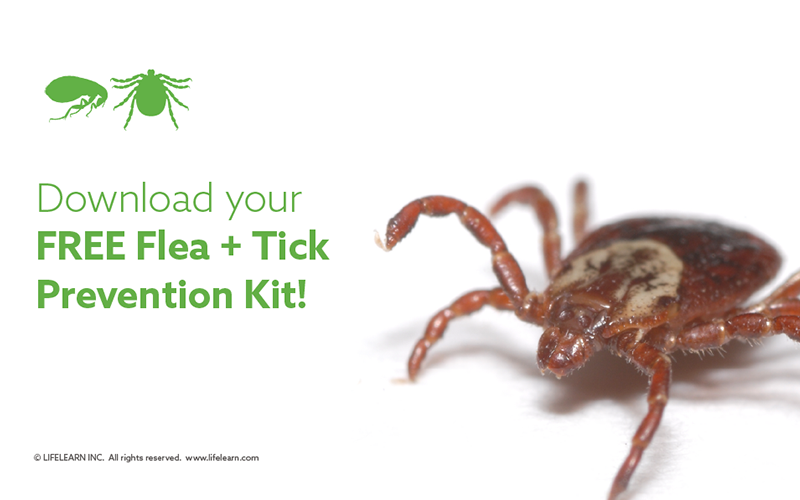Educating your clients early this year about flea and tick prevention for their pets has extra importance, given the pandemic year we’ve had and the following three facts:
- The weather’s warming.
- The vaccines are rolling out.
- Stay-at-home orders are slowly lifting in some regions.
Here’s why this year is more important than ever to download our free Flea + Tick Prevention Kit to remind and educate your clients about protecting their pets from the risk of flea infestations, tapeworm, Lyme disease, and other tick-borne diseases.
Facts for Flea and Tick Season
 Fleas
Fleas
- Fleas are flightless insects that jump onto hosts to feast on blood.
- A female flea can consume 15 times its body weight in blood each day.
- The average flea has a lifespan of two to three months. With an ample food supply, an adult flea can live up to 100 days.
- A female flea can lay about 2,000 eggs over the course of its life, and lay eggs within 35 to 48 hours of its first blood meal.
- Fleas can carry several diseases, and act as hosts for the flea tapeworm (Dipylidium caninum), one of the most common tapeworms for dogs and cats.
Ticks
- Ticks are members of the arachnid family (which includes spiders, scorpions, and mites).
- Ticks begin seeking a blood meal (or “questing”) when temperatures rise above 4 degrees Celsius (39 degrees Fahrenheit).
- Ticks cannot jump or fly. They find a blood meal by crawling to the tips of grasses and shrubs and latch onto passing animals or people.
- The black-legged tick (widely distributed across Canada and the U.S.) is the most common carrier of Lyme disease.
- Female ticks lay between 3,000 to 6,000 eggs during their life.
Ticks Are Spreading
The tick population is growing and spreading. According to the Centers for Disease Control and Prevention (CDC), the number of U.S. counties with blacklegged ticks (the most common carrier of Lyme disease) has more than doubled over the past 20 years, and the number of tick-borne diseases is increasing at a record pace.
Fleas and Ticks Have Never Practiced Physical Distancing
People will undoubtedly follow safe physical distancing and other COVID-19 safety protocols throughout the spring. Yet fleas and ticks have never practiced physical distancing. They’re going to do what they’ve always done. Namely, lie waiting in grasses and leaves, waiting to hop aboard a passing pet for a blood meal. In the process, pets will be exposed to the risk of tapeworm, Lyme Disease, and other flea- and tick-borne diseases.
Early Warmth and Wet Weather
Ticks become active and begin seeking a blood meal (or “questing”) when temperatures rise above 4 degrees Celsius (39 degrees Fahrenheit). Fleas thrive when the weather is warm and humid, meaning rain and flooding can create the perfect breeding ground for flea populations to boom. Ticks also survive better and thrive in humid conditions. And according to predictions by Accuweather and the National Weather Service, this spring will be an early one with milder-than-normal temperatures across portions of North America. Spring is also predicted to be a wet one with the risk of flooding in regions.
In other words, with Mother Nature expected to deliver the kind of conditions this spring in which ticks and fleas can flourish, now is a good time to download our free Flea + Tick Prevention Kit to educate more pet owners and protect more pets.
Why Early Client Education About Flea and Tick Prevention for Pets Is Extra Important

The importance of educating your clients early this year about flea and tick prevention for their pets comes down to how this blog began. People have been indoors through a long winter of restrictions. All that many people can think about is not being indoors, and as they look forward to spending as much time outside as possible, many are simply going to look right past flea and tick prevention for their pets.
To save time and simplify educating your clients about flea and tick prevention, download your free Flea & Tick Awareness Kit.
Our free kit includes:
- An educational ClientEd handout for your clients (that you can print or email)
- A printable poster for your clinic
- Two social media images that you can post on Facebook to further educate your clients around the importance of flea and tick protection





